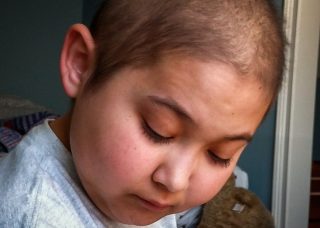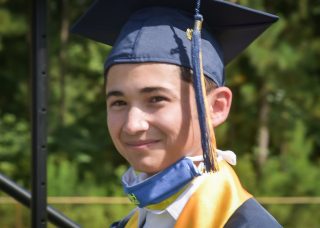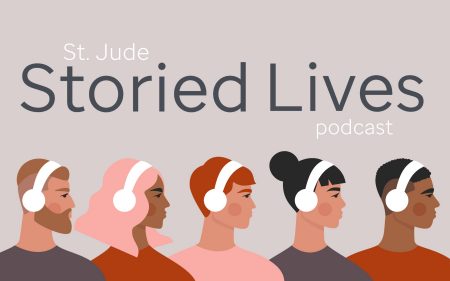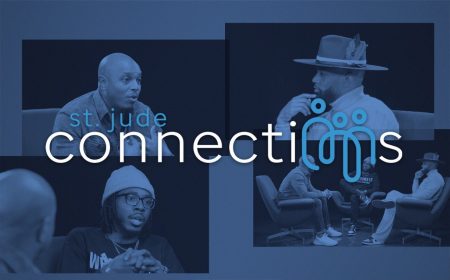
Prayers answered: After surviving childhood cancer, St. Jude patient heads to college
In a journey that changed his entire family, John went from the brink of death to valedictorian of his high school class, and beyond.

October 19, 2020 • 6 min
As a COVID-19 precaution, John’s college in South Carolina assigned each incoming freshman a one-hour window of move-in time, and maybe that was a good thing – a way for John’s parents, Kathy and Rich, and his older sister, Isabella, to stay focused on moving boxes and not their emotions.
John wore his mask, so it was hard for his parents to read his face. Was the look in his eyes nervousness or expectancy?
They wondered. And asked. Repeatedly.
“Stop it,” said John. “I’m not anxious. I’m not nervous. I’m happy. This is awesome.”
So they tried to play it cool.
Six years earlier, John had been so sick they didn’t think he’d pull through. But doctors at St. Jude Children’s Research Hospital were able to save him.
“We had to make funeral arrangements for him,” said Rich. “It was that bad.”
Without St. Jude, the family believes, John wouldn’t be here today.
“It took a team to get John where he is today,” said Kathy, “but he pushed through, and I think a lot of that grit and determination is what helps him today.”
Now here he was in his dorm room, starting college.
And all the emotions bobbed back up.

Memories of the ICU
John's family remembers being in the intensive care unit as vividly as if they were still there. The ambient noise of the machines performing their vital functions. John’s murmurs in his sleep. The sounds when he cried out. Some minutes felt like hours, with little to mark the time but the back and forth of the medical team pacing outside John’s room – the metronome of the St. Jude ICU.
Isabella readjusted her brother’s body to be more comfortable. Rich took a moment to talk to the doctor. John was in there somewhere, deep inside his own body.
Each day brought new complications, minor emergencies that, if left unattended, could become serious – quickly. There was a fear of total collapse, a moment when some new thing in the body fails, pulling everything down with it: their entire lives.
They began to feel like friends with the nurses. And Isabella, watchful, took in their rhythms and tried to learn from them – to do what they do to help her brother. The doctors sensed her interest in medicine and taught her how to lead rounds.
Sometimes Kathy stole time away to leave John’s side and go outside to walk the perimeter of the St. Jude campus, an oasis fenced off from the noise of downtown Memphis. The sky was endless, the grass still soft and green, the smell of earth comforting. She breathed in and out. It helped, and she went back inside.
Dark point #1: Something is trying to kill John
John had no visible signs of cancer before the bruises that appeared in early 2012 during a soccer game.
“When we were in the car, he takes off his shirt and I notice all these bruises on his back,” said Rich.
By the next day there were red spots covering John’s body.
“So obviously, with the power of Google – you Google ‘bruises’ and bad stuff comes up,” said Rich. “Leukemia came up.”
They soon learned John had T-cell acute lymphoblastic leukemia, a treatment-resistant form of the disease.
"Well, the first thing I did was start bawling of course," said John, who was then 11. "That’s kind of your first instinct."
The family consulted with doctors, researched leukemia and decided St. Jude would give John his best shot at a permanent cure.
Once they arrived at St. Jude, Rich said, he “grabbed John literally in my arms because he was that sick” and he carried him inside.
Dark point #2: It won’t go away
John never had an easy time during his two-and-a-half years of chemotherapy, but he did achieve remission. He bumped along in treatment until the awful day in 2014 when Rich got that phone call.
“I’ll never forget,” said Rich. “I was in my office in North Carolina when the doctor called. And he said, ‘I’ve got some terrible news. John’s relapsed. You’ve got to get him back here.’"
“We literally, you know, 90 days from being done and putting cancer, at least the treatment portion, in the rearview mirror. And John relapsed.”
Chemotherapy wouldn’t be enough to cure John. He needed a bone marrow transplant – the last resort for a cure.
Dark point #3: total collapse
The transplant procedure itself went well with his mom as his donor. But soon after, things got hard.
His spleen was sequestering the transplanted cells, so the doctors removed it. John’s newly transplanted cells then engrafted, which is what you want.
But then the bottom fell out.
“I don’t think anyone, even my care providers, could have imagined I would experience such severe complications, especially respiratory failure and paralysis,” said John.
The paralysis was a condition called Guillain-Barré, an autoimmune syndrome in which the immune system attacks healthy nerve cells.
“Being in the ICU for months on life support, while just having had a stem cell transplant, is unimaginable,” said Rich. “It’s to me as dark of a period as a family could think about.”
“We were very lucky that we chose to be in a place like St. Jude for this period of time for John because we strongly believe he would have died anywhere else. The acuteness of his Guillain-Barré and how fast it was moving, and the care he got in the ICU, was care that probably wouldn’t have happened anywhere else.”
A professional bond
From day one, John’s leukemia oncologist devoted himself to the mystery of John and his cancer. Rich, a businessperson, trusted him and felt a bond.
“There were many times where he’s had to tell me some things that are the worst of the worst,” said Rich. “But what I appreciated from him was I never had to second guess it, and to this day I know what he says is open and honest to the best of his medical ability. There’s no sugar coating.”
In his capacity, Rich wants to do what he can to help the next family facing cancer, so he's become a member of the Professional Advisory Board for ALSAC, the fundraising and awareness organization for St. Jude.
He meets regularly with other volunteers – virtually these days – to provide guidance to ALSAC on strategic fundraising issues and ways to raise awareness for St. Jude.
His professional friendship with John’s leukemia oncologist lasts to this day.

A deepened faith
Early on in John’s cancer treatment, Kathy decided to make gratitude and reflection a part of their daily journey. She started a blog to not only update their family and friends back home about John’s condition, but also process her thoughts.
One entry details a night when John threw up his chemotherapy pill and she and Rich dug through the vomit to make sure they didn’t need to re-administer the medicine.
This was their reality. Cancer was incredibly hard. She needed her friends and family to see it, too.
But the blog post became a launch for something she’d been thinking about a lot since John got sick: the biblical concept of “drinking the cup,” or fully accepting your life, complete with its attendant joys and sorrows. She wrote:
As I was wiping John’s face and holding his little head up, I clenched my teeth and said over and over and over, ‘Drinking the cup!’ By saying it, I acknowledged the path that God asked me to walk. I have come to understand what is my unique sorrow, John’s cancer, and what is my unique joy, John is ALIVE. My cup holds my truth; my son has leukemia, and my family is forever changed. Acknowledging what is in my cup has caused me great sadness, but it has allowed me to grow spiritually.
Kathy wrote her blog for years until one day she decided to stop. She needed to let go, she explained. John was done with treatment. She needed to ease up and let him live his life. She needed to live hers.
It’s been an ongoing process, this letting go.
Saying goodbye to John on the day he moved into the dorm was hard. She coached herself through it.
“I tried to remind myself that we prayed for this moment,” said Kathy. “This was among the many things I have wanted for John: to go to high school, to go to the prom, to graduate, to go to college, to have a girlfriend. As hard as it is, he deserves to move forward and have people support him.
“I don’t want my anxiety to weigh down on him because I want this for him. I want him to have a beautiful life and to do things other children his age are doing, so I just try to tell myself: This what I prayed for years ago.”








